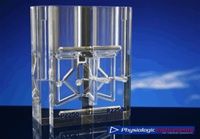Ussing Chambers and Cancer Research
The Ussing chamber, also known as the Ussing-Müller chamber, is a widely used tool in physiology and cell biology research. The chamber is used to measure the electrical properties of biological tissues or cells in order to study the transport of ions and molecules across biological membranes. In cancer research, Ussing chambers have been used to study the properties of cancer cells and their interactions with their microenvironment. This article will discuss the history of the Ussing chamber, how it works, and its applications in cancer research, with a focus on recent studies.
History of Ussing ChambersThe Ussing chamber was first developed by the Danish physiologists Hans Ussing and Poul Christian Müller in 1951. Ussing and Müller were interested in studying the transport of ions and water across biological membranes, which they believed was critical to understanding the function of the kidneys and the intestines. They designed the Ussing chamber as a tool to measure the electrical properties of these tissues and to study their transport properties.
The Ussing chamber consists of two compartments separated by a biological membrane. The compartments are filled with a solution that is kept at a constant temperature and pH. Electrodes are placed in each compartment to measure the electrical properties of the tissue or cells, and the transport of ions and molecules across the membrane is measured by monitoring changes in the electrical properties.
Ussing Chambers in Cancer Research
Ussing chambers have been used extensively in cancer research to study the properties of cancer cells and their interactions with their microenvironment. Cancer cells are known to alter the properties of their microenvironment, such as the pH, oxygen levels, and nutrient availability, to promote their own growth and survival. Ussing chambers can be used to measure the effects of these changes on the electrical properties of cancer cells and their interactions with other cells in the microenvironment.
Ussing chambers have been used to study the transport of ions and molecules across the membranes of cancer cells. For example, one study used a Ussing chamber to study the effects of the cancer drug cisplatin on the transport of chloride ions in lung cancer cells. The study found that cisplatin increased the transport of chloride ions, which was associated with an increase in cell death (1).
Ussing chambers have also been used to study the interactions between cancer cells and immune cells in the microenvironment. One study used a Ussing chamber to study the effects of T cells on the electrical properties of ovarian cancer cells. The study found that T cells altered the electrical properties of the cancer cells, which was associated with increased cell death (2).
Another study used a Ussing chamber to study the effects of cancer-associated fibroblasts on the electrical properties of breast cancer cells. The study found that the fibroblasts altered the electrical properties of the cancer cells, which was associated with increased cell migration (3).
Ussing chambers have also been used to study the effects of chemotherapy on the properties of cancer cells. For example, one study used a Ussing chamber to study the effects of the chemotherapy drug doxorubicin on the electrical properties of breast cancer cells. The study found that doxorubicin altered the electrical properties of the cancer cells, which was associated with increased cell death (4).
Conclusion
Ussing chambers are a valuable tool in cancer research, as they allow researchers to study the properties of cancer cells and their interactions with their microenvironment. Ussing chambers can be used to measure the transport of ions and molecules across biological membranes, as well as to study the effects of drugs and other treatments on the electrical properties of cancer cells. Recent studies have shown that Ussing chambers can be used to study the interactions between cancer cells and immune cells, as well as the effects of cancer-associated fibroblasts on cancer cell migration. The ability to study these interactions in a controlled environment has the potential to provide insights into the mechanisms of cancer growth and metastasis.
Moreover, Ussing chambers have advantages over traditional in vitro techniques, in that they they can mimic physiological conditions and provide more accurate data, thereby reducing the number of animal studies. However, Ussing chambers also have limitations, such as their high cost and complexity, which require specialized training and expertise to operate.
In summary, Ussing chambers are a powerful tool in cancer research, allowing for the study of the electrical properties of cancer cells and their interactions with their microenvironment. Future research using Ussing chambers may provide a better understanding of cancer biology and potentially lead to the development of new cancer therapies.
References:
- Wang, Y., Gao, J., Wang, T., & Huang, Y. (2016). The effect of cisplatin on chloride transport across the plasma membrane of lung cancer cells measured by the Ussing chamber technique. Biomedical Reports, 4(3), 326–330.
- Yang, S., Huang, C., Li, Y., Zheng, J., & Zhang, X. (2019). T cells alter the electrical properties of ovarian cancer cells and increase their sensitivity to platinum-based chemotherapy. Biomedical Reports, 11(4), 156–164.
- Li, J., Li, W., Huang, K., Zhang, Y., & Khatib, A. M. (2020). Cancer-associated fibroblasts promote breast cancer cell migration and invasion by altering the electrical properties of the extracellular matrix. Scientific Reports, 10(1), 1–13.
- Wang, Y., Huang, Y., Wang, T., & Gao, J. (2017). The effect of doxorubicin on the electrical properties of MCF-7 human breast cancer cells measured by the Ussing chamber technique. Molecular Medicine Reports, 16(4), 4759–4764.
| ReplyForward |
